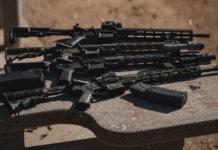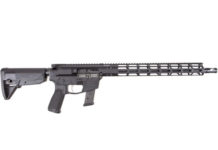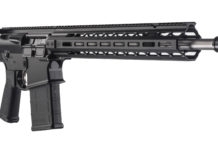Steve Coulston embarked on a year long journey to transform his IWI Tavor into something very special. Here’s what happened…
If you are looking for a compact rifle that provides short to medium target engagement capabilities in close quarters, urban warfare and open terrain, is battle proven and available to the average, good guy, Joe Blow civilian, the IWI Tavor may be just what the doctor ordered. The 5.56x45mm NATO chambered bullpup rifle sports a chrome lined, 16-inch 1:7 twist cold hammer forged barrel, long stroke piston design and is 100% ambidextrous. It comes in a variety of configurations, colors and can be converted to different calibers and left or right hand eject.
While all that is awesome, it is not earth shattering or groundbreaking news, at least not anymore. Just about every gun author has written about the IWI Tavor in the past year including this one. It’s not the golden unicorn anymore. All the waiting and lusting finally culminated in the US debut of the SAR version of the Tavor back in 2013. Back logs and wait lists were the norm. Price gouging and empty promises kept it out of the hands of many hopeful buyers. But once the hype died down and supply met demand all was right in the bullpup world.

Once the dust settled and folks had a chance to get some time on the Israeli/US platform it was time for the next big thing. During SHOT Show 2014 I had a chance to shoot the new 9mm conversion kit. It was fun and all, but I’m not going to lie… I’ve had better. As an early Tavor owner, I was looking for something that would really blow my skirt up. During my time at SHOT 2014 I had a chance to talk to the team at IWI and heard all kinds of promises and teases about new calibers in .300 blackout and a larger version to handle .308 and other heavier calibers. That’s all fine and dandy and I really look forward to those future developments but for the time being I want to spice up my Tavor love life. What could I do to really make my Tavor fit my shooting style and add a few personal touches that would make this firearm unique to me? I decided to embark on a journey that would span a year obtaining existing parts, waiting for future parts and sending it out to get some new threads.
Geissele Automatics: Super Sabra Trigger Pack
Usually the first upgrade I make to any rifle is the trigger. Bullpup rifles are notorious for having clunky triggers. The IWI Tavor is actually not too shabby for a bullpup, but it ain’t no AR. The manufacture trigger pull hovers between 11 and 12 lbs. It is heavy and makes precision shots more challenging and follow-up shots slow. A trigger upgrade was definitely in order. For an AR that is pretty easy to do as there are plentiful options from numerous manufactures. The Tavor is a different story. Even at the time of this writing there are only a very small handful of options. I started looking into triggers for the Tavor last year. When I went to SHOT Show 2014 I had the opportunity to check out, the then prototypical, Geissele Super Sabra Trigger Pack. Bill Geissele was nice enough to give me the run down and lets me manipulate and dry fire one of the installed prototype packs. I was very impressed, however, I would have to wait about 10 months before I could get my hands on a production run Super Sabra.

The Super Sabra, when placed side-by-side with the manufacture trigger has some obvious unique features. First is the housing. The manufactured trigger housing is made of plastic, while the Geissele offering features a CNC 6061-T6 aluminum housing and a type 3 anodized hardcoat. The pins that hold the internals together are also in different locations. It should be noted Geissele will not warrant a trigger pack that has been disassembled, so don’t do it. The laser engraved, “Do not disassemble” should be a good reminder.
The Super Sabra is a two-stage, adjustable trigger. The first stage is user adjustable from 3.5 to 5.5 lbs. The trigger comes set at 3.5 lbs from the factory. Installation takes about 90 seconds. After verifying the firearm is clear and safe, simply punch out the two pins that contain the trigger housing, pull out the original and install the Super Sabra in reverse order. Function-check the rifle and you should be good to go. On the range the trigger really shines. I kept mine at the factory, first stage setting of 3.5 lbs. The first stage has ¼ inch take up before you hit the wall. The second stage has a really crisp break at 2 lbs. The reset is short, measuring at 1/8th of an inch and has an audible click. The Super Sabra improves accuracy and really aids in quick follow up shots. While it isn’t cheap, nothing worth buying ever is. The Super Sabra retails for $350.00 and is currently one of 3 or 4 manufactures currently offering Tavor trigger upgrades.
Gear Head Works: Tavor Modular Forearm (TMF)
During my earlier reviews on the Tavor, I noted areas where I could see improvements. One of my suggestions was to incorporate a way to mount more rails for accessories to the stock forend as well as incorporate the means to house an internal white light. While IWI offers a proprietary rail section that will attach to the underside of the forend, it wasn’t available back when I bought my Tavor. During my research for an alternative I came across a small company called Gear Head Works.

At the time, Gear Head Works was a one-man shop and was already busy prototyping a solution to all my Tavor gripes. Paul, owner, operator and former IDPA competitor started Gear Head Works (GHW) in 2012 selling charging handles for the Aug/MSAR. Soon he started prototyping parts for the Tavor. Like me, Paul was an early adopter of the Tavor. Once he took possession of his Israeli bullpup, he spent the next few months scorching his retinas in front of a computer screen solid modeling a series of upgrades.
The Tavor Modular Forearm (TMF) really addressed my initial Tavor criticisms. The manufactured plastic forearm on the Tavor angles up and was designed that way to work with the IDF principle of “6 points of contact.” The forend works with the oversized trigger guard, which is really a place to lock the support forearm while the support hand grasps the forend.
The TMF makes use of the air space inside the forend. The TMF is a replacement aluminum forend it runs parallel to the barrel and is “U” shaped in profile. It has slots at the 3, 6 and 9 o’clock positions that are specifically made to accept the Magpul MOE Rail Sections. The front end of the forend has a removable cap/clamp that will securely accommodate a 1-inch diameter flashlight. The light is specifically designed for use with a tape switch, which can be run out the back of the TMF and secured to the left or right side.
Installation is easy. First, install your MOE rails (if desired) to whatever side of the TMF you want an accessory on. Next, install the light by removing the front cap from the TMF. Then insert the light and secure the clamp and run the tape switch cable out the back. Reinstall the end cap in the reverse order and replace the factory forend with the TMF. For my rifle, I utilized the Magpul MVG. This allows me to use a vertical grip without having to mount a rail. This makes for a very clean look. I prefer this set up over the IDF method of shooting. Shooter’s preference of course. Cost for the TMF is $129.99 with free shipping.

Elzetta B335 Light
For the light I used the bullet proof Elzetta High Output Bravo which is a two cell light that boasts 650 output lumens. This mated perfectly with the TMF and I secured the pressure switch to the left side of the TMF using the MOE Illumination Kit. I have been using Elzetta lights for a while now and have been very impressed with their engineering and quality. The housing is made of 6061-T6 hard-anodized aluminum and feature fully potted electronics for extreme impact resistance. How extreme? Well, I have seen them use one to hammer nails into a 2×4 and still operate just fine. The Bravo features Elzetta’s Automatic Voltage Sensing (AVS) patent pending technology. AVS is a LED driver enhancement that will boost the lumen output to 900 when the head is installed on a 3 cell (9v) body. The light has a run time of 90 minutes, is water proof to 10 meters and is impact resistant from drops as high as 5 meters. Even with the Elzetta Bravo installed in the TMF, the 51T Advanced Armament BLACKOUT Flash Suppressor I fixed to the end of the barrel allows the mounting of a sound suppressor without conflicting with the light. The Elzetta B335 light with pressure switch will run you $239.00.
Gear Head Works: FLEx – Fulcrum Located Extra Swivel:
The FLEx, which stands for Fulcrum Located Extra Swivel, is a replacement part for the factory plastic cover that seals up the unused ejection port on the Tavor. The manufactured cover that comes with the factory rifle doesn’t provide a very effective seal. This results in gasses escaping through the factory cover during the course of fire. As the Tavor is a bullpup, the ejection port is right under the shooters face, any escaping gases end up all over the shooters grill. This look has become known as “Tavor Face.” When shooting suppressed, this issue is exasperated.
With the FLEx installed those gasses are not as much of a problem. It provides a solid seal and incorporates an integral QD sling attachment point. The FLEx moves the sling further forward on the Tavor, which results in the Tavor not hanging as low as it would if I were using the factory rear QD points. Installation of the FLEx is pretty straightforward. There are a few small screws under the factory cover that can be lost if you are not aware they are present. If you are going to run your Tavor suppressed, you need a FLEx. The FLEx will run you $56.99 with free shipping.

Gear Head Works: Razorback Rail
The newest offering from Gear Head Works is the Razorback top rail. For anyone who has shot a Tavor, they will notice they have to get their face really low on the rifle in order to properly see through optics or sights. I really didn’t like having to shoot this way, so for me personally, the Razorback rail is an outstanding investment. Its made of 6061-T6 aluminum and fixed my low cheek weld problem. It is a replacement 1913 compatible rail that places optics and sights at the same height as one would find when using and AR15. This allows the natural use of common AR compatible optics and sights. Unlike the factory rail, the rail mounts to the barrel, which allows the zeroed optics to remain with the barrel during caliber changes. There are slots milled into the side of the rail, which not only reduce the weight of the rail, but they also accommodate the Gear Head Works Universal Side Accessory Mounting System. The USAMS is a small section of rail that can be mounted to either side of the Razorback and is perfect for adding a laser designator or light, especially if the end user is not using the TMF. With the massive amount of parts designed for the AR market, the Razorback makes perfect sense and is highly recommended. It should be noted that the addition of the Razorback will remove the integrated BUIS that come with the Tavor. The Razorback comes in both a full length and short length version. I opted for the full-length rail as I plan to add BUIS in the future. The Razorback will set you back $169.90 for the full length and $134.99 for the shorter version.
Leopold Mark 4 HAMR
Optics selection took some thought. The Tavor is compact which lends itself to up close and personal work. A red dot type optic would be appropriate for this application. That being said the 16.5-inch barrel allows the Tavor to stretch its legs for further engagements. In this case, magnification makes the most sense. I figured I would select an optic that could accommodate both applications well, while maintaining rugged construction that would hold up to copious amounts of abuse. The Leopold Mark 4 HAMR fit the bill perfectly.

The HAMR is a tough as nails optic designed for close to medium range engagements. It is made of 6061-T6 aircraft grade aluminum and built like a Battleship. (I was a sailor; give me a break.) I chose the duel optic version, which features a 4x24mm magnified optic with a top mounted DeltaPoint 1x optic designed for fast acquisition of closer targets. To switch from magnified to non-magnified, simply raise the cheek weld slightly and the cage protected, DeltaPoint triangle reticle comes into view. The HAMR lens features Leupold’s Diamond Coat protective coating, which aids in abrasion resistance and light transmission. The eye relief is generous, which for me works out to 3-1/2”. The retical is crystal clear and focus can be adjusted by rotating the lockable fast focus eyepiece located at the rear of the optic. The reticle on the HAMR can be had in numerous illuminated configurations. I chose the CM-2 and 7.5 MOA Delta reticle, which has BDC ranges out to 900-meters and it also accommodates for moving targets. There are seven illumination brightness settings that have an off feature between each setting. This allows the optic to be turned off and on and maintain the previously used illumination setting without all the excessive rotating of the dial.
The HAMR was designed for use with an AR15 type rifle so the addition of the Gear Head Works Razorback Rail puts the HAMR right where it needs to be for proper head position and cheek weld. It should be mentioned, however, the barrel location on a Tavor differs from one on an AR. Meaning, the distance from the centerline of the optic over centerline of the bore on the Tavor is much higher than on a traditional AR. In my current configuration, the Razorback Rail is 1-1/2 inches higher than the flat top rail on an AR15. This means holdovers at closer ranges will need to be accounted for appropriately especially when using the DeltaPoint. The HAMR has its own mount so no other tools or mounting solutions are necessary. The HAMR was built military tough, and is built by one of America’s most well respected optic manufacture. The HAMR with DeltaPoint has an MSRP of $1,939.99.
Blowndeadline Custom: #cerekotethatshit
For the most part, the rifle and all its working parts were complete. There was only one thing left to do. #cerekotethatshit . That’s right; in order for this Tavor Transformation to be complete I sent it to my buddy, Mike Sigouin over at Blowndeadline Custom. Mike is a gun guy and artist when it comes to Cerekote and custom stencils. When I say artist, I mean freaking, metal head, Cerekote master, genius. You can call him the Yoda of Cerekote. His work and attention to detail are amazing regardless if he is working on a single color pistol slide or a hyper complicated color scheme for an AR15. Mike uses a combination of Cerekote H-Series and Cerekote Armor Clear for an amazing, durable finish. For my Tavor I wanted something unique. That is a little hard to find these days. I have seen solid color Tavors, multicam Tavors, Kryptek Tavors and many others. All badass to be sure, but I wanted different. After all, it took a year to complete this project, so why settle for same ol’, same ol’? I opted to go with a battle worn look in an earthy color scheme. Why, you may ask? First, I have never seen one done up that way. It kind of gives it a HALO or Aliens pulse rifle look. Also, this Tavor wasn’t going to be a safe queen. So I figured go with something that will look awesome, yet not give me a heart attack if it gets scratched up and banged around. Who the hell am I kidding; all my shit gets beat up. I digress. I sent my Tavor to Mike while I was waiting for my Geissele Super Sabra Trigger and Leupold HAMR to arrive. Mike took the time to breakdown, blast and de-grease all the parts. He Cerekoted just about everything on the rifle including the rails, takedown pins, trigger, charging handle, magazine and frame. He was kind enough to send progress shots throughout the project, which only built the anticipation. Cost will vary depending on what work you would like done to your firearm, knife or whatever. Check out his price list for more information.

The day I got it back was like Christmas in October. I ripped the package open, ran to the workshop, and installed the Elzetta Bravo light, Geissele Super Sabra Trigger Pack and Leupold HMAR as fast as I could. She was finally complete and looked freaking fantastic! All the waiting, planning and research had finally paid off. I was looking at a one-of-a-kind Tavor, which was unique, only to me. (If you have one like it, let me live in my dream world for a little bit.) Once on the range, she shot like a champ. I couldn’t be happier with the way it turned out or how it performed. Now to name her…
The manufactures that I worked with to acquire the parts are top notch and I highly recommend ordering from any of them. As this Tavor Transformation comes to a close my mind wanders to what other transformation project awaits around the corner… For you Tavor owners out there, please take the time to check out the mentioned manufactures and let them help you with your Tavor Transformation.
* The views and opinions expressed on this web site are solely those of the original authors and contributors. These views and opinions do not necessarily represent those of Guns & Tactics Magazine,
the administrative staff, and/or any/all contributors to this site.






[…] been fans of the Israeli-based IWI Tavor for quite some time. Hopefully we’ll get our hands on their new MASADA pistol for a thorough […]
Comments are closed.